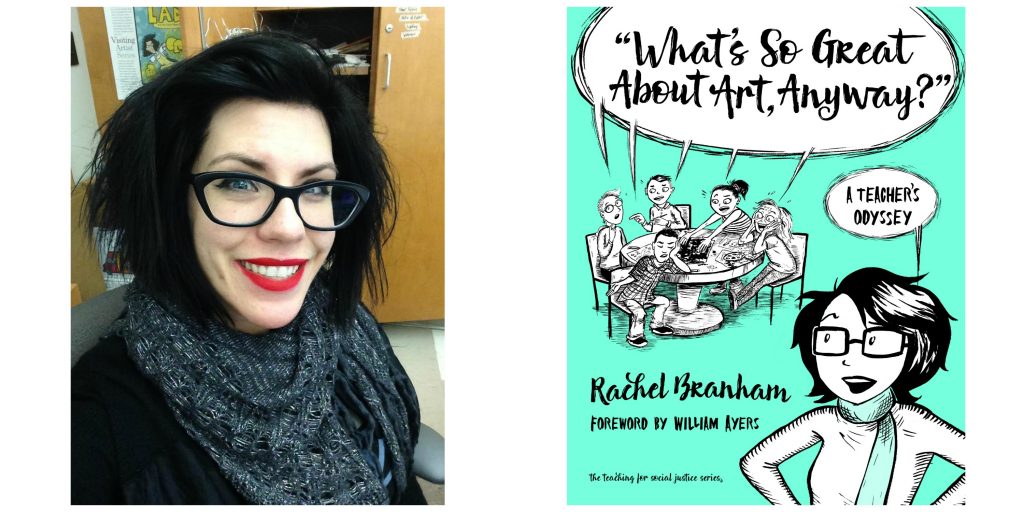An interview with Rachel Branham, author of What’s So Great About Art, Anyway? A Teachers Odyssey on the fate of arts education under the new administration.
Can you share your thoughts on the future of arts and public education under the new administration?
Everyone wants to make changes in education, but no one can decide on what is best. I don’t have all the answers, but as a public school art teacher, I am making a case for the immediate preservation and implementation of arts in public schools in the Age of Alternative Facts! First of all, who is Betsy DeVos, the nominee for Secretary of Education? We know that she did not attend public school and did not send her own children to public schools. She is chair of a pro-school choice advocacy group, the American Federation for Children, and strives to privatize education by using public funding for students to attend private schools, where accountability, student growth, and achievement are inconsistent and questionable at best. Funding programs designed to dismantle public education is unethical and undemocratic.
Devos’ legacy includes siphoning funds from public schools to for-profit charters. She is a ‘champion for change and choice,’ however the change she seeks leaves many students and their families with far fewer choices!
And what about charter schools?
We also know that charter school staff are largely overworked, do not have union safety nets, and lack resources. Their curriculum is unregulated, their progress unmonitored, and all this leaves the futures of the children they are responsible for uncertain.
I don’t doubt that DeVos cares about children, but her heart and her wallet are in two different places, and she needs to think hard about that.
Michigan is my home state, and I was fortunate enough to attend a public school that had visual, performing, and applied arts all represented. Just do a quick Google search of Detroit charter schools’ websites however and you will be hard-pressed to find any evidence of the arts.
Public schools are equalizers, where the arts— once seen as frivolous and exclusive— become accessible and interwoven in children’s lives. The arts are in public schools because the public wants it! The arts are part of Michigan’s State education standards, but if Betsy DeVos dismisses standards (as many charter schools reject or do not follow), then who is to say if the arts will survive?
What do you think may happen to the National Endowment for the Arts?
The defunding of the National Endowment for the Arts is another seriously problematic possibility we face! The argument that this will save money is unrealistic— the NEA uses only 0.02% of the budget, even though its impact is huge. I can’t emphasize enough that the arts and humanities belong to all the people of the United States–that’s what the first part of the National Foundation for the Arts and Humanities Act of 1965 is all about.
The primary function of NEA is to provide funding to artists and to bring the arts into schools and communities, which makes the arts accessible for, as the document states, all the people of the United States. But it goes beyond the individual; the NEA supports a huge range of projects in performing, visual, and applied arts from small artist collectives, to metropolitan museums, to national festivals.
So, why are the arts important?
Art serves as a type of mirror. It reflects ourselves, our visions and our truths. If we can’t be thoughtful, we will be careless, joyless.
I guess if history tells us anything, it’s that regardless of the state of things, art finds a way to emerge from the chaos and wreckage. But at what cost? Will the only exposure we see come from renditions of old operas and copies of flowery still lifes? What of the polarizing, politicizing rawness of art?
Once today’s working artists fade out (to poor healthcare or otherwise), who will replace them if kids don’t learn and experience art in schools? What if our children have no opportunities for artistic expression?
Every day a child is without holistic arts instruction, whether it’s building a model, making a sketch, or writing a short story, will be a missed opportunity. Engagement in the arts during youth helps preserve the parts of our brains that understand visual and spatial complexities, creative problem solving, and critical thinking skills that are vital for our future.
I believe in art as our primary vehicle of self-expression. It is universal, yet deeply personal. Art allows us to share our unique, authentic voices. Our youngest citizens deserve time to learn how to develop their own voices, and arts education is a way to do this.
Any final thoughts?
People Power–I believe that we, the people, will need to do more of the work to keep the arts afloat. It can be through individual donations of supplies, volunteering to teach (or take!) classes, and by financially or physically supporting organizations that provide classes and make art accessible to the public.
Of course, write to your senators and be involved in your local politics! If you support freedom of speech as much as our new president seems to, use it to support our arts— historically our most valuable of communication methods!
Rachel Branham is an art educator in the Marblehead Public Schools, Massachusetts and is author of “What’s So Great About Art, Anyway?” A Teacher’s Odyssey (Teachers College Press 2016).

